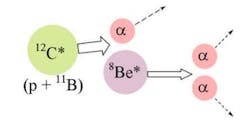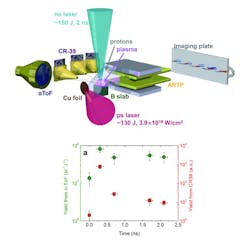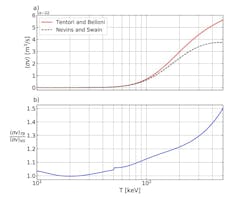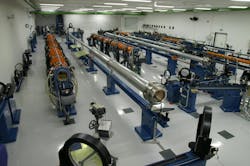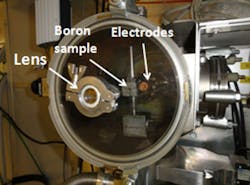The success of the inertial confinement reactor of the National Ignition Facility (NIF) at the Lawrence Livermore National Laboratory in California suggests that lasers and other machines can be used also for triggering aneutronic fusion reactions, which require higher kinetic energies of the fuel particles—but lead to a more efficient energy extraction process. Fusion experiments today mainly focus on the deuterium-tritium (DT) reaction; however, recent research made using lasers turned the neglected proton-boron reaction into a possibility (see Fig. 1).
Limits of a DT reaction
The weakest point of the DT fusion lies in the copious fluence of fast neutrons, which make it appear energetically so attractive. Studies made primarily for tokamaks show that “a high flux of 14.1 MeV neutrons will lead to damage levels of 100 displacements per atom in some components.”1 The first atom invested by such a neutron will have the power to displace others, creating a wave of displacements that quickly brittle the neutron-facing components of a DT reactor and leading to an abrupt change of their certified properties.
Ed J. Pickering of the Department of Materials of Manchester University, who led that study,1 further warns that none of the presently available candidate materials will perfectly fit a reactor’s first wall or blanket. This implies there aren’t yet suitable materials for running a commercial DT system continuously.
In a DT reactor, 80% of the energy released by burning the fuel is neutron kinetic energy absorbed and converted to heat by a blanket, inside of which a coolant flows. A second coolant exchanges the heat, carrying it outward to move a turbine connected to a generator. All losses in this process contribute to the calculation of QE, a figure of merit representing the ratio between the useful electricity produced by the system and the electricity fed for running it. The remaining 20% of fusion power is carried by energetic alpha particles confined within the plasma to sustain reaction continuity.
The efficiency of the fusion gain itself must abundantly exceed “break-even” or a modest “ignition.” The relation between the fusion energy extracted and the energy input spent on heating and maintaining the fuel over fusion time (QFus) should be about 5 or above.
Except for grid electricity generation, the external containment requirements dictated by the neutron flux and the associated energy extraction process—both common to magnetic and inertial confinement DT reactors—make the use of such systems problematic in more dynamic contexts like transportation. In short: much energy will be spent in the ancillary systems and there are disadvantages derived from tritium breeding and radioactive waste handling.
Proton-boron
Beyond tritium, boron is not radioactive and quite abundant on Earth—the United States Geological Survey (USGS) estimates 1.2 billion tons. The 3 α charged particles in the almost aneutronic proton-boron reaction (see Fig. 1) may be captured by a magnetic field for a more functional conversion of kinetic energy into electric energy than using the thermal extraction above.
This reaction was discarded in the 1970s because cross-section estimates appeared discouraging.2, 3 The Lawson criterion, which compares the rate of energy generated by fusion reactions within the fuel to the rate of energy losses to the environment, shifted to an extended confinement time and higher plasma densities (e.g., nτ around 6 × 1021 m-3s), and the reactivity peaks above 200 keV ion temperature. Since boron features a higher atomic charge than tritium, this fusion solution was deemed impracticable because of the ion and electron collisions and the associated Bremsstrahlung radiation that was supposed to surpass the per-unit volume the power density volume needed for fusion.
In degenerate plasmas studied in astrophysics, some transitions between electron states are forbidden. To offset Bremsstrahlung (the electromagnetic radiation produced by deceleration of a charged particle when it’s deflected by another charged particle), Eric Lerner, the founder of LPP Fusion, suggested that for fusion to advantageously exploit a quantum suppression effect for which electrons in strong magnetic fields must occupy only discrete or “Landau” energy levels, “very little energy can be transferred to the electrons in such collisions,” he argued in 2003.4 “The large magnetic fields required for this effect are only achievable with the dense plasma focus or with lasers, another strong advantage for these two approaches to p-11B fusion.”
A further solution is to keep a suitable temperature difference between ions and electrons to limit Bremsstrahlung. According to research in 2022, achieving p-11B fusion requires the electron temperature to be one-third that of the ions. Laser-accelerated protons in the fuel could produce fast α-particles, which contribute to heating the mix to the required temperature difference by the protons scattering with the helions.
Laser impact on p-11B research
A significant contribution to a progressive upgrade of the cross-sections and the associated reactivity came during the past 20 years from experiments of laser fusion using intense picosecond- and nanosecond-laser beams to induce the p-11B reaction in specifically designed targets.
A laser beam is directed immediately to targets containing boron and hydrogen impurities or to a pitcher that emits a proton beam subsequently sent to a catcher, the boron target (see Fig. 2). Over time, laser-induced fusion experiments produced a surprisingly elevated amount of α particles. Yields span from 105 sr-1 up to 1010 sr-1 particles. The precise measurement of the size of the orbital motion of the primary α particle with l = 3, which is emitted to ground state 0+ in the reaction, eventually led to a reconsideration of the cross-section data.
In a crescendo, Sikora and Weller found a 15% enhanced reactivity in 20165 over the earlier values of Nevins and Swain in 2000.6 Putvinski et al. found in 2019 a 20% increase around 300 keV.7 Tentori and Belloni calculated a 30% to 50% higher reactivity at similar temperatures in 2023 (see Fig. 3).8 In terms of power density, the new insights on the cross-sections at different proton energies projected the proton-boron fusion toward the limits of the Bremsstrahlung barrier and possibly beyond (see Fig. 4).
Analyzing the relation between the nuclear reactions described above and the target density, S. J. Liu and co-workers at the Institute for Fusion Theory and Simulation of the Zhejiang University in China found in 2023 that the “effect of quantum degeneracy will increase the fusion yield mediated by the effect of the reduced stopping power of the beam protons.”9
On this premise, Liu suggested a more sophisticated “pitcher-catcher” process where laser pulses first produce a dense degenerated target “in which contributions of bound and free electrons to the stopping of protons can be completely disregarded and dramatically reduced respectively.” A proton beam directed to the dense target will produce a correspondingly high emission of α particles with an increase of orders of magnitude.
P-11B laser fusion implosion
The Australian HB11 Ltd. Pty. is working on a “proof of concept” of net p-11B laser fusion. Co-funded in 2017 by Heinrich Hora, a former professor at the Sydney University of NSW who had been researching proton-boron laser fusion since the early 1970s, the company’s goal is bringing fusion energy to the grid soon. HB11 has strong financial support from the Australian government and a wide network of international partners in America and Europe. In fiscal-year 2023, the Department of Energy (DOE) awarded an INFUSE project to its American subsidiary, the HB11 USA.
The fusion research strategy of HB11 includes designing hydrogen-boron targets, simulating, and experimenting the peculiarities and behaviors of boron fuels, plus developing high-energy laser hardware. At the present stage, the preparation of suitable targets for fusion experiments is of paramount importance. With worldwide access to top boron chemists and their laboratories, the Australians can manufacture laser targets with micro- and nanostructured boron that include two-dimensional borophene as well.
In 2023, HB11 took part in an international initiative that explored the alternative of a plasma-assisted vapor phase deposition of thin films of hydrocarbon plasma polymers on substrates of boron nitride. The samples were then tested for α-particles yield at the TARANIS laser of the Queen’s University in Belfast and the PERLA B laser at HiLASE, in the Czech Republic, with one top emission of 108 α-particles sr-1 in Belfast.10
In April 2024, HB11 joined researchers at the University of Bordeaux (France), the Institute of Plasma Physics and Laser Microfusion (Poland), GSI Helmholtz Research Center (Germany), the Hellenic Mediterranean University (Greece), and the Soreq Nuclear Research Center (Israel) to organize the “equation of state” experiments at the PALS laser facility in Prague. PALS, the Prague Asterix Laser System, is a terawatt iodine laser designed to deliver an on target irradiance of about 3 × 1016 W cm-2.
Supported in part by the European PROBONO and LASERLAB V funds, the experiments focused on the properties and behavior of millimeter-size targets holding boron nitride at Megabar pressures and billion degrees Kelvin temperatures under a laser irradiance in the order of 5 × 1015 W cm-2 (see Fig. 5).
A return of the Dense Plasma Focus
The Dense Plasma Focus (DPF) is a machine first built independently in the U.S., and in Russia in the 1960s. In a DPF, electromagnetic forces generate, accelerate, and pinch plasma.
How does it work? The device consists of two coaxial cylindrical electrodes insulated at one end and open at the other (see Fig. 6). Electrodes are enclosed within a vacuum chamber where light elements fuels are injected. The cathode is grounded, the anode connected to a fast switch which, at closure, discharges the current accumulated by a capacitor bank. The switch closure releases several kilovolts between the electrodes, producing an electric field enhanced by the insulator. In the high voltage field, the gas ionizes. Forming filaments, a current sheath moves down radially along the electrodes. The sheath, while collapsing at the end of the inner electrode, leads to the concentration of the plasma filaments that pinch together, eventually forming knots—dense, magnetically confined bright and hot regions or plasmoids lasting 10 billionths of seconds. Plasmoids feature radii of hundreds of microns and electron densities in the order of 1024 to 1026 cm-3 also emitting x- and gamma rays and beams of accelerated ions and electrons. Intense neutron radiation characterizes the plasmoids as a favorable environment for fusion.
Within the range of 50 to 106 J, the properties of large and small DPF are intrinsically alike, a scaling flexibility that led in the past to considerable expectations on rapidly designing adaptable fusion machines.
In 1970, researchers at the Frascati DPF facility in Italy, funded by Italy’s NRC and Euratom, proved that the fusion processes within the plasmoids belonged the beam-target class, which, by the principles of the time, was unsuitable to yield net fusion. DPF devices were confined to the production of hard x-rays and other industrial applications, including, paradoxically, the emission of high energy neutrons for testing critical tokamak components.
In 2023, the International Scientific Committee on Dense Magnetized Plasma concluded that: “The plasma focus is seen to provide a counterexample where a warm magnetically confined plasma targets an energetic ion beam that repeatedly passes through it are naturally created. This creates a unique opportunity for the scientific community to explore a new pathway towards the realization of a net fusion energy producing system.”
“Repeatedly” being the key term, the committee’s conclusion promotes the DPF to a primary competitor in fusion again. Note: Inside plasmoids, there are no such things as a target and a beam of ions and neutrons as in laboratory, the respective terms refer to the deduced velocity distribution of the ion products.
Laser meets DPF
Incorporated in 2003, LPP Fusion in New Jersey gained experience in p-11B fusion research using DPF. In 2019, the company achieved a plasma temperature of 200 keV and the highest plasma purity to date.
The main problem with DPF is that the increase of fusion yield above a peak current of 1 MA flattens into a plateau, so its wall-plug efficiency has not advanced over time. To favor the fusion processes within the plasmoids, LPP Fusion is moving to denser gas fills.
“Denser plasma causes smaller, shorter-lived plasmoids, but the yield of the density increases faster than lifetime reduction of the plasmoids,” Lerner explains. “The DPF approach rests on using the natural instabilities of the fusion plasma rather than fighting them—it goes against much conventional engineering practice. Almost all machines are designed to function stably, suppressing instabilities. This is just not possible with plasma. Imitating nature, we use the instabilities to create fusion plasma in a reliable way. This makes the approach harder to understand for many engineers and administrators.”
In Europe, the Institute of Nuclear Physics of the Polish Academy of Science in Krakow has been involved for many years in DPF and fusion research. Professor Marek Scholz noticed that in the reaction, “the hydrogen-boron plasma should be created and compressed in the pinch phase, while maintaining the standard conditions operation of the PF device; this can be achieved by adding boron to the PF system at a suitably selected moment.”
Scholz and colleagues recently proposed and calculated an experiment of simultaneously plasma doping during the discharge of a PF using the laser ablation on a boron target found at the anode of the machine.11 The plume of plasma injected by a Nd:YAG laser adds boron ions to the hydrogen ions created in the discharge phase. This solution led to a better synchronization over the use of a fast gas valve injection—improving the conditions that favor fusion (see Figs. 7 and 8).
In 2022, the European Union promoted four years of action PROBONO, which stands for “PROtonBOronNuclear fusion,” to encourage an interdisciplinary research network that brings researchers and innovators together to investigate a topic of their choice for four years, with single projects being funded for up to €150,000 (US$163,000) per year.12
A flexible reactor concept based on the p-11B reaction could favor the use of fusion energy for railway engines or ships, eventually determining an overall implementation of fusion energy in a process comparable to the widespread of electricity in the early 20th century.
REFERENCES
1. J. Pickering et al., Entropy, 23, 98 (2021); https://doi.org/10.3390/e23010098.
2. D. C. Moreau, Nucl. Fusion, 17, 1, 13 (1977).
3. W. Buck et al., Nucl. Phys. A, 398, 189 (1983).
4. E. J. Lerner, in Current Trends in International Fusion Research—Proceedings of the Fifth Symposium (2003), edited by E. Panarella, NRC Research Press, National Research Council of Canada, Ottawa, ON, Canada (2007) and E. J. Lerner, S. M. Hassan, I. Karamitsos-Zivkovic, and R. Fritsch, J. Fusion Energ., 42, 7 (2023); https://doi.org/10.1007/s10894-023-00345-z.
5. M. H. Sikora and H. R. Weller, J. Fusion Energ., 35, 538–543 (2016); doi:10.1007/s10894-016-0069-y.
6. W. M. Nevins and R. Swain, Nucl. Fusion, 40, 865 (2000).
7. S. V. Putvinski, D. D. Ryutov, and P. N. Yushmanov, Nucl. Fusion, 59, 7, 076018 (2019).
8. A. Tentori and F. Belloni, Nucl. Fusion, 63, 086001 (2023); doi:10.1088/1741-4326/acda4b.
9. S. J. Liu et al., arXiv:2304.08357v1 [physics.plasm-ph] (2023); https://doi.org/10.48550/arXiv.2304.08357.
10. M. Tosca et al., Front. Phys. (Jul. 26, 2023); https://doi.org/10.3389/fphy.2023.1227140.
11. M. Scholz et al., J. Fusion Energ., 38, 522–530 (2019); https://doi.org/10.1007/s10894-019-00225-5.
12. See www.cost.eu/actions/CA21128.
Vittorio Lippay
Vittorio Lippay has been a member of the Institute of Physics since 2018 and a member of the Institute of Chartered Shipbrokers (London branch) since 2012.
